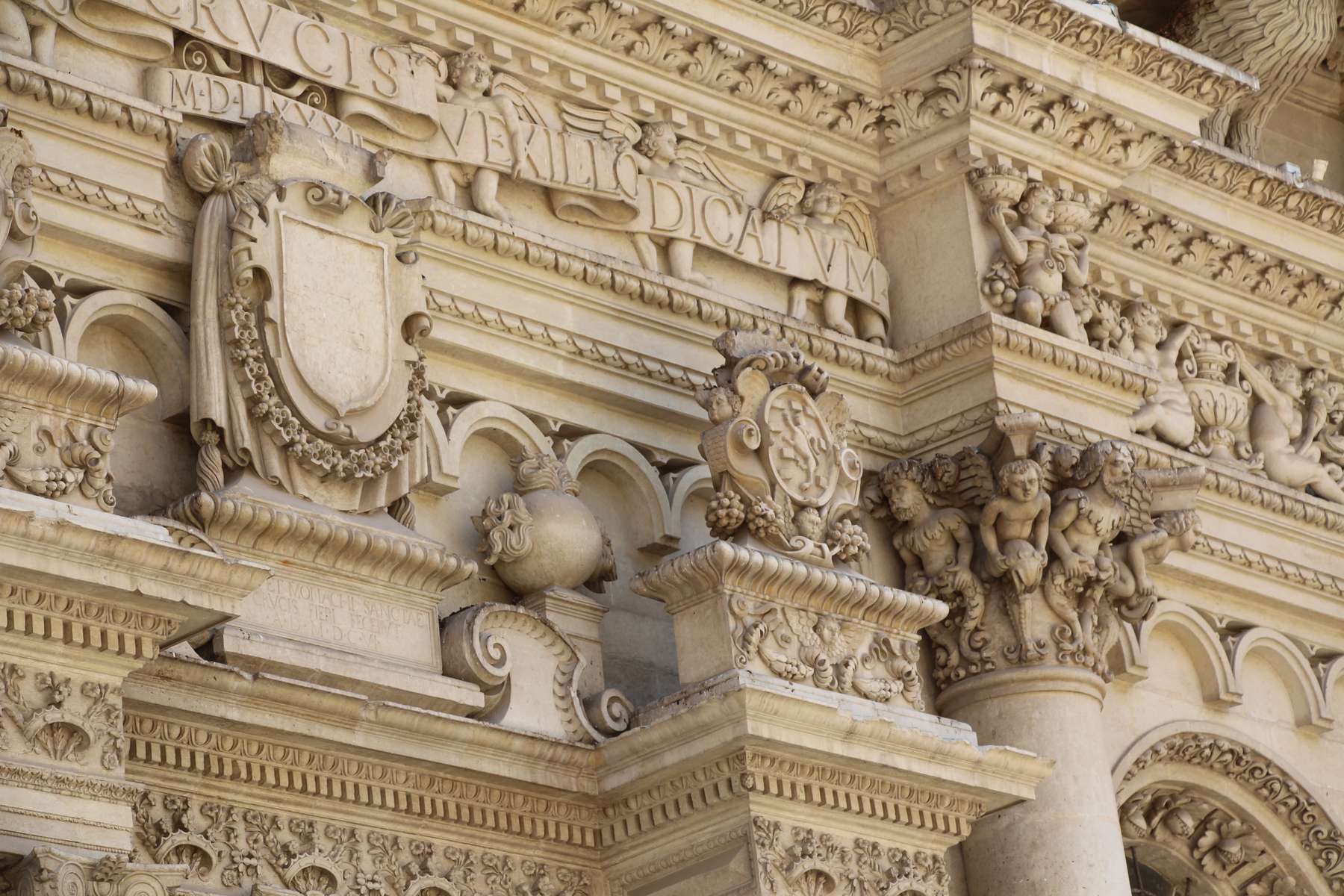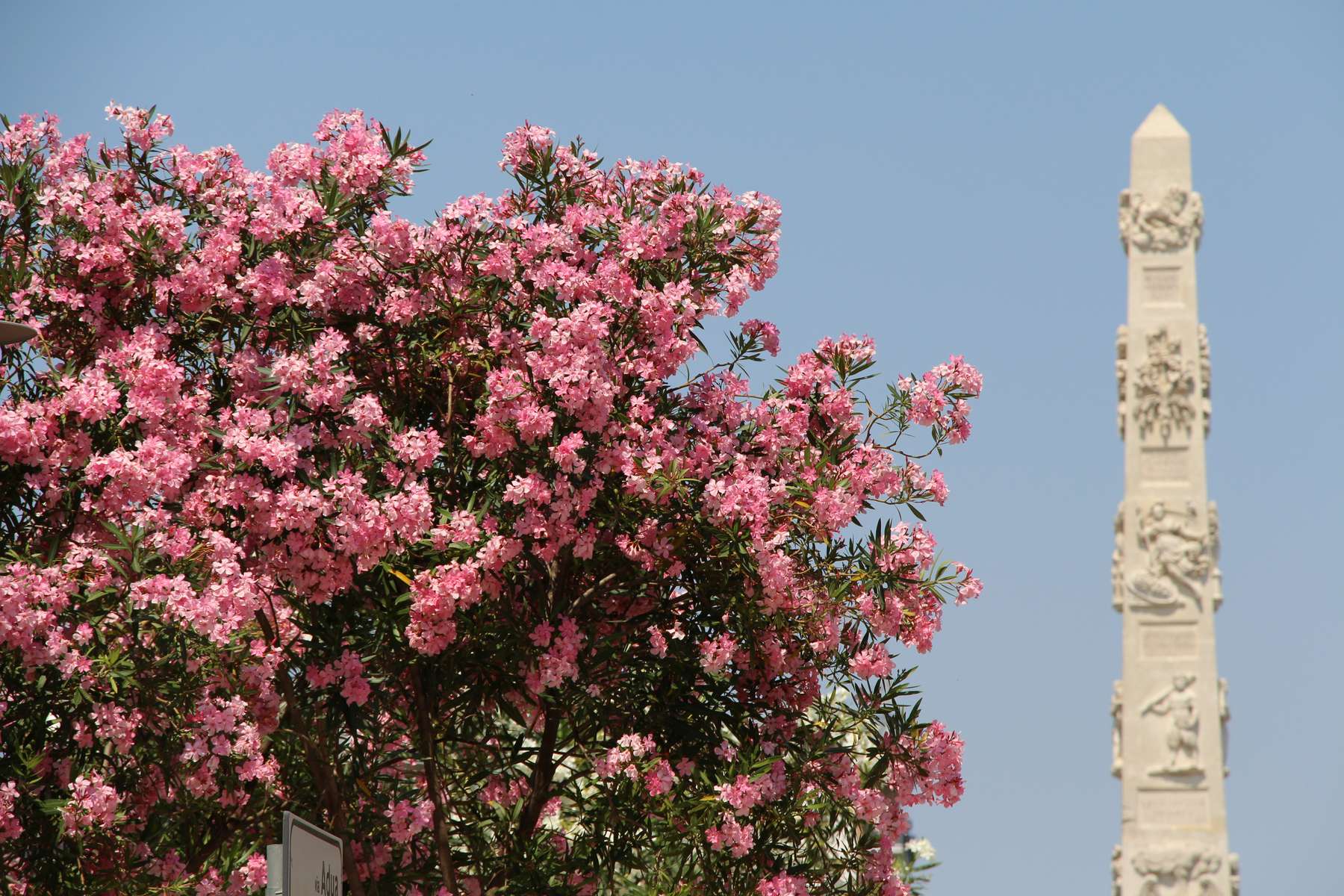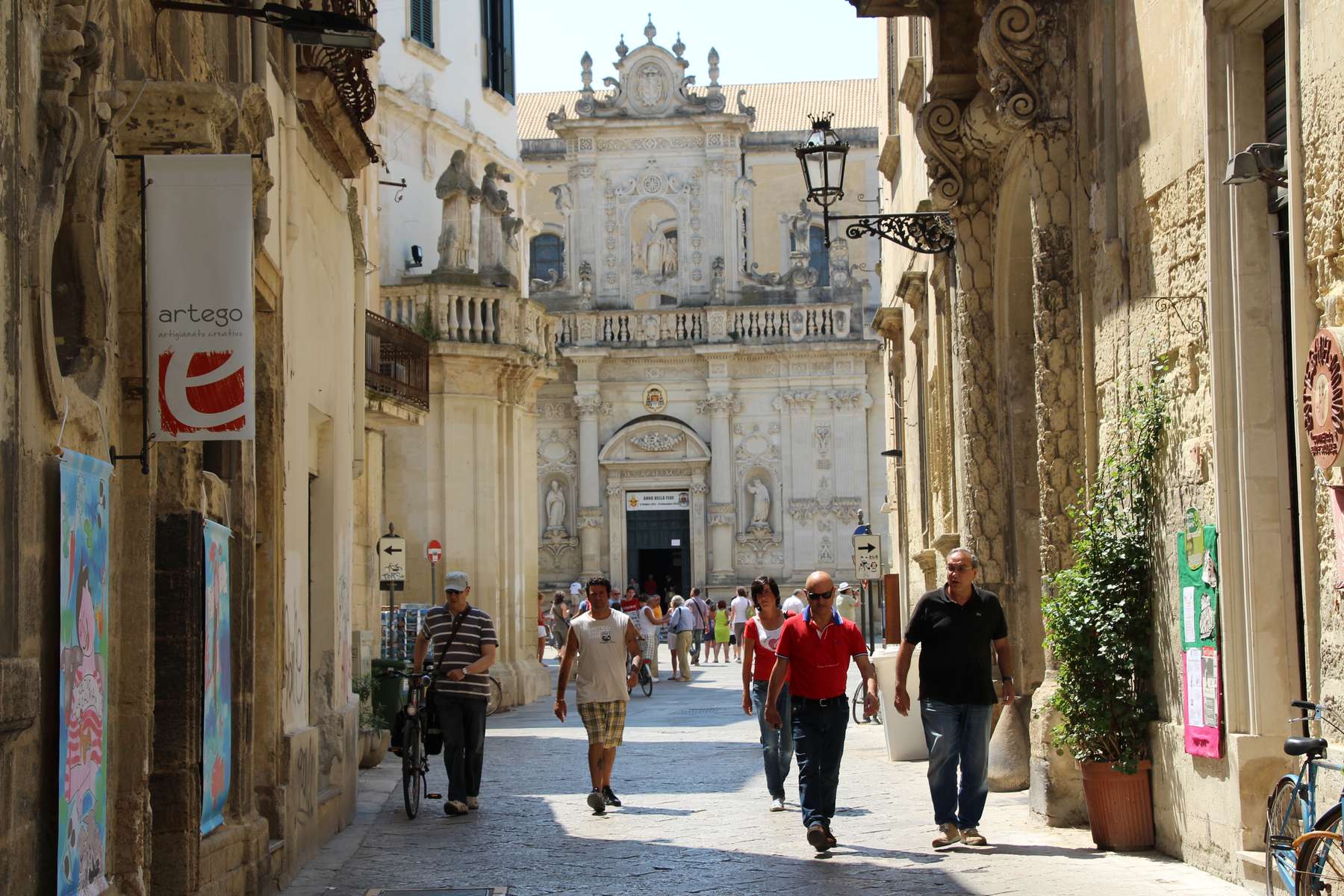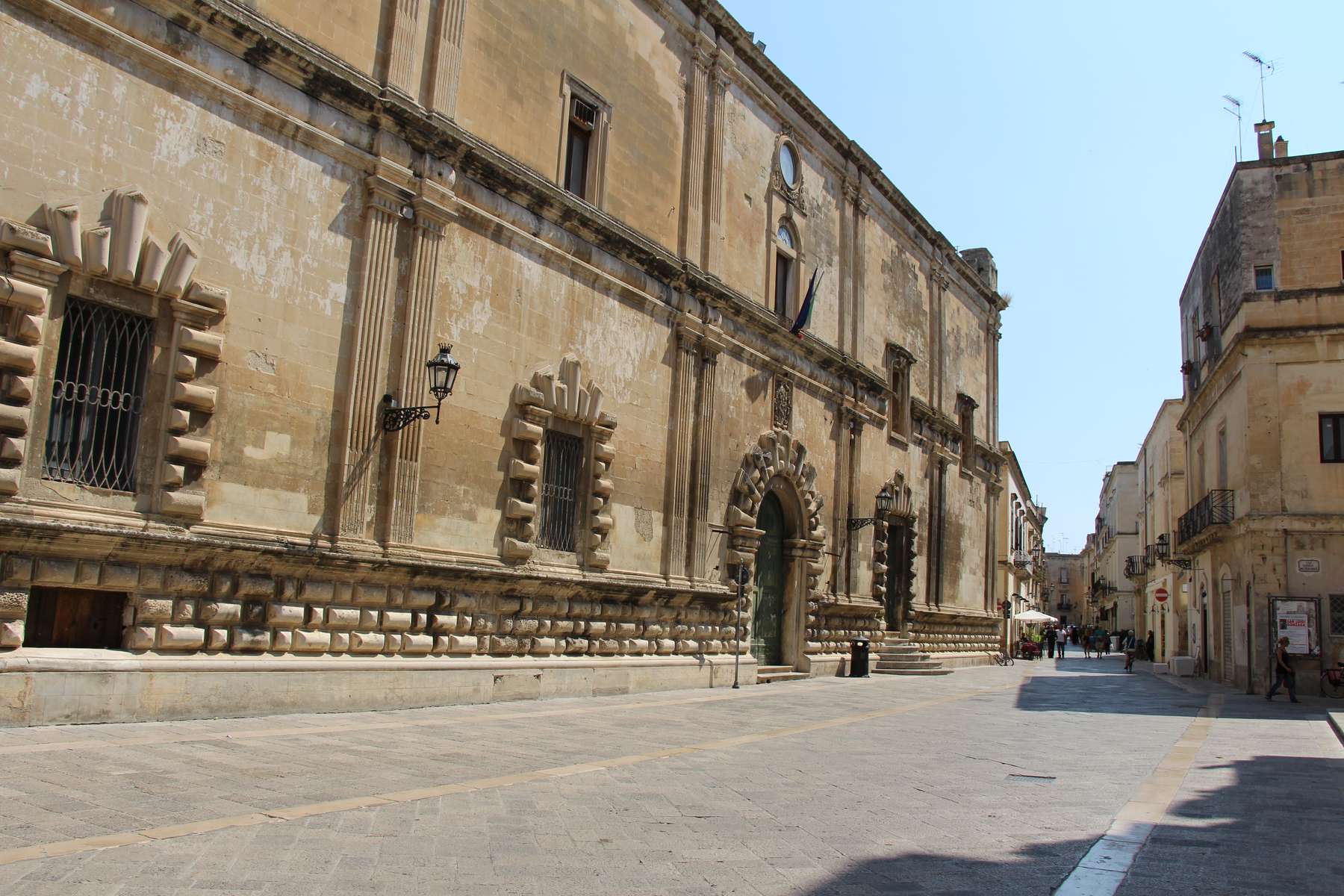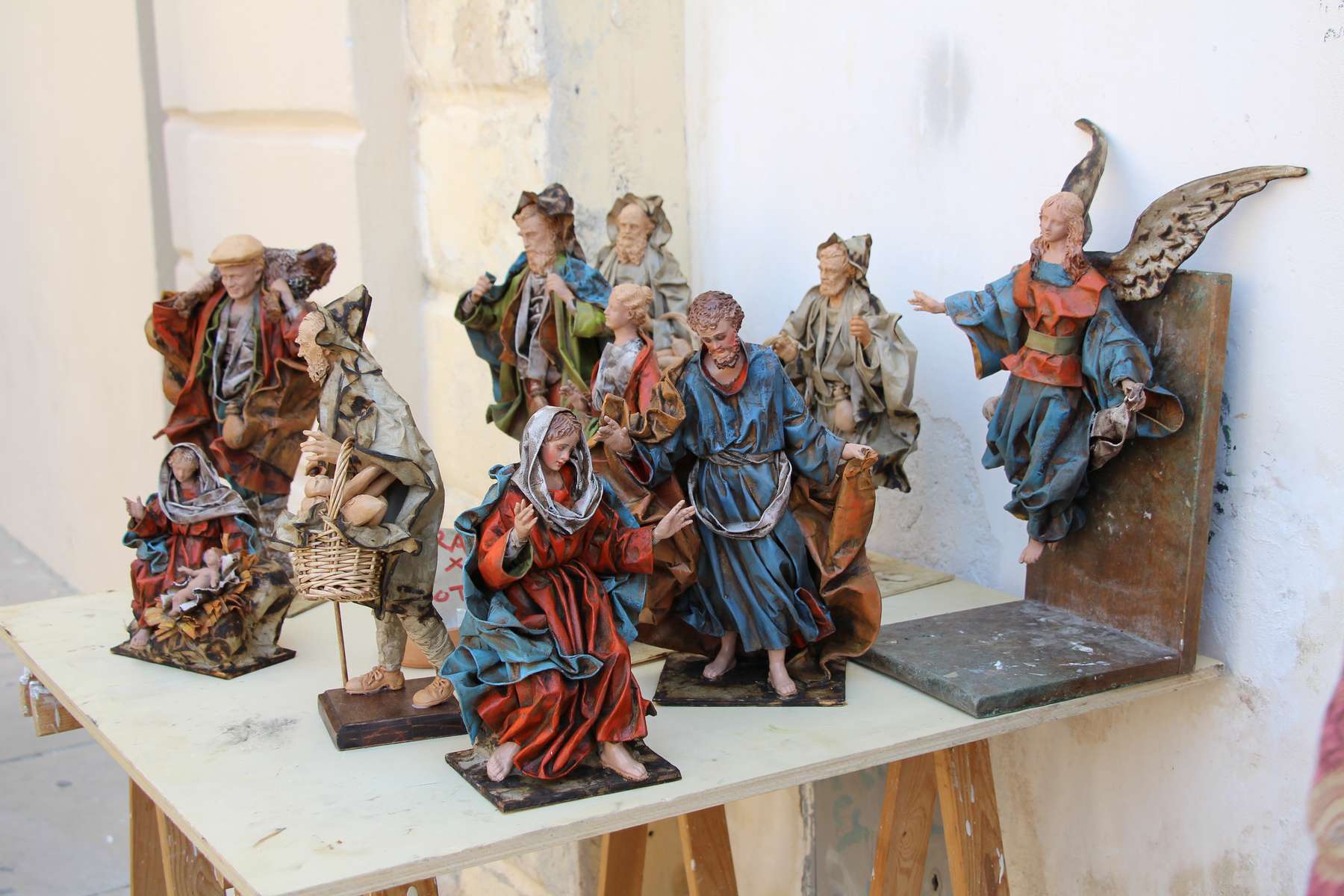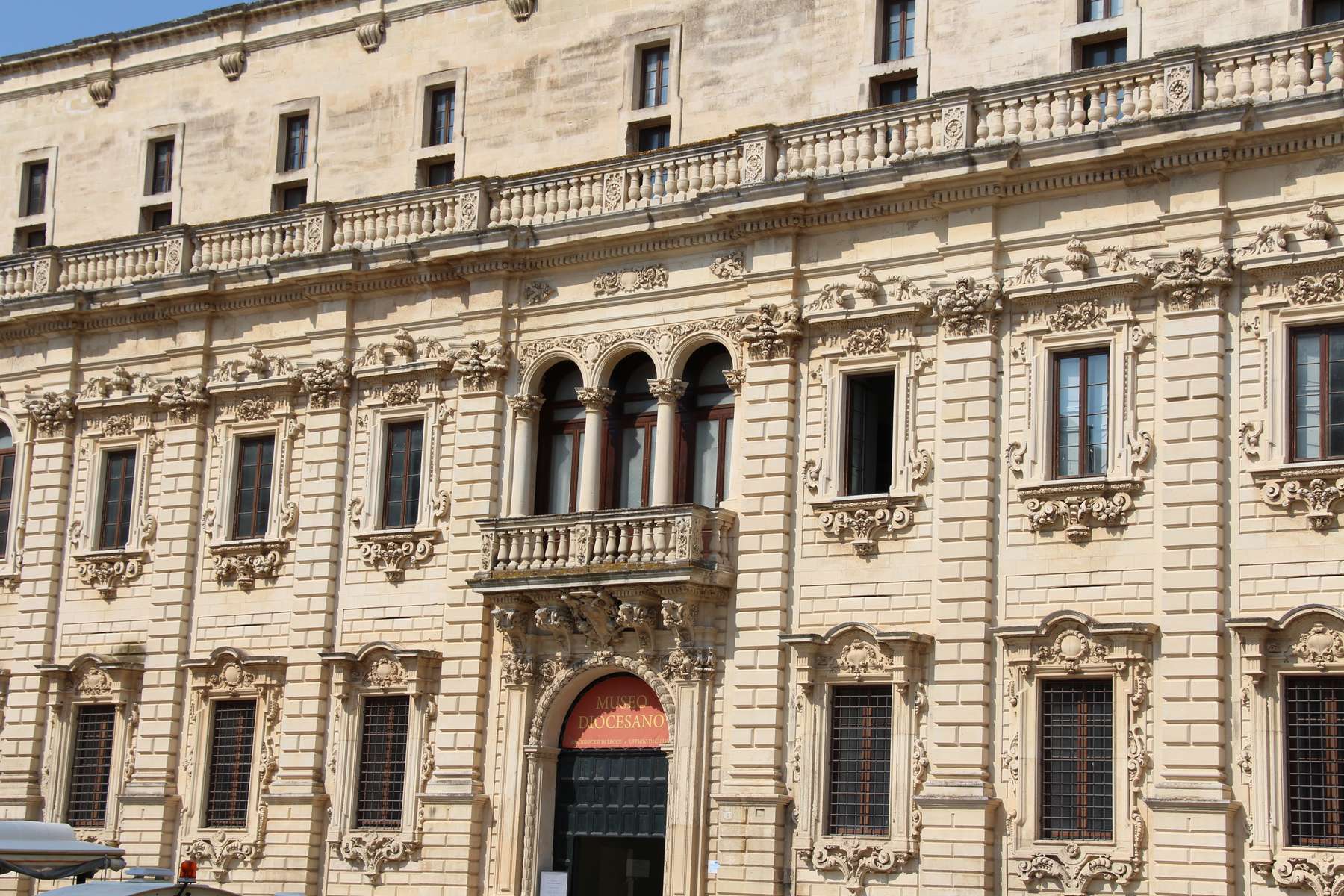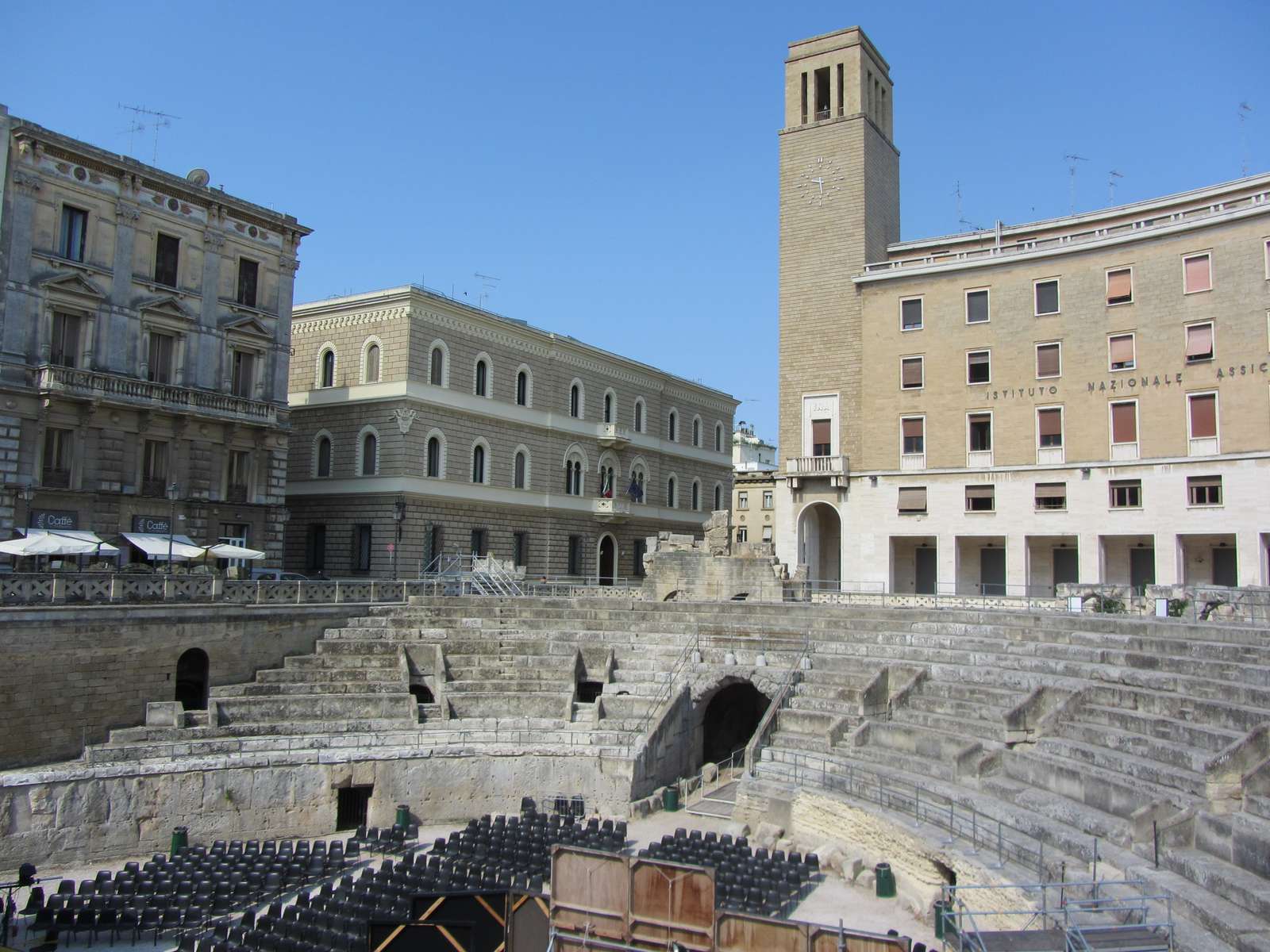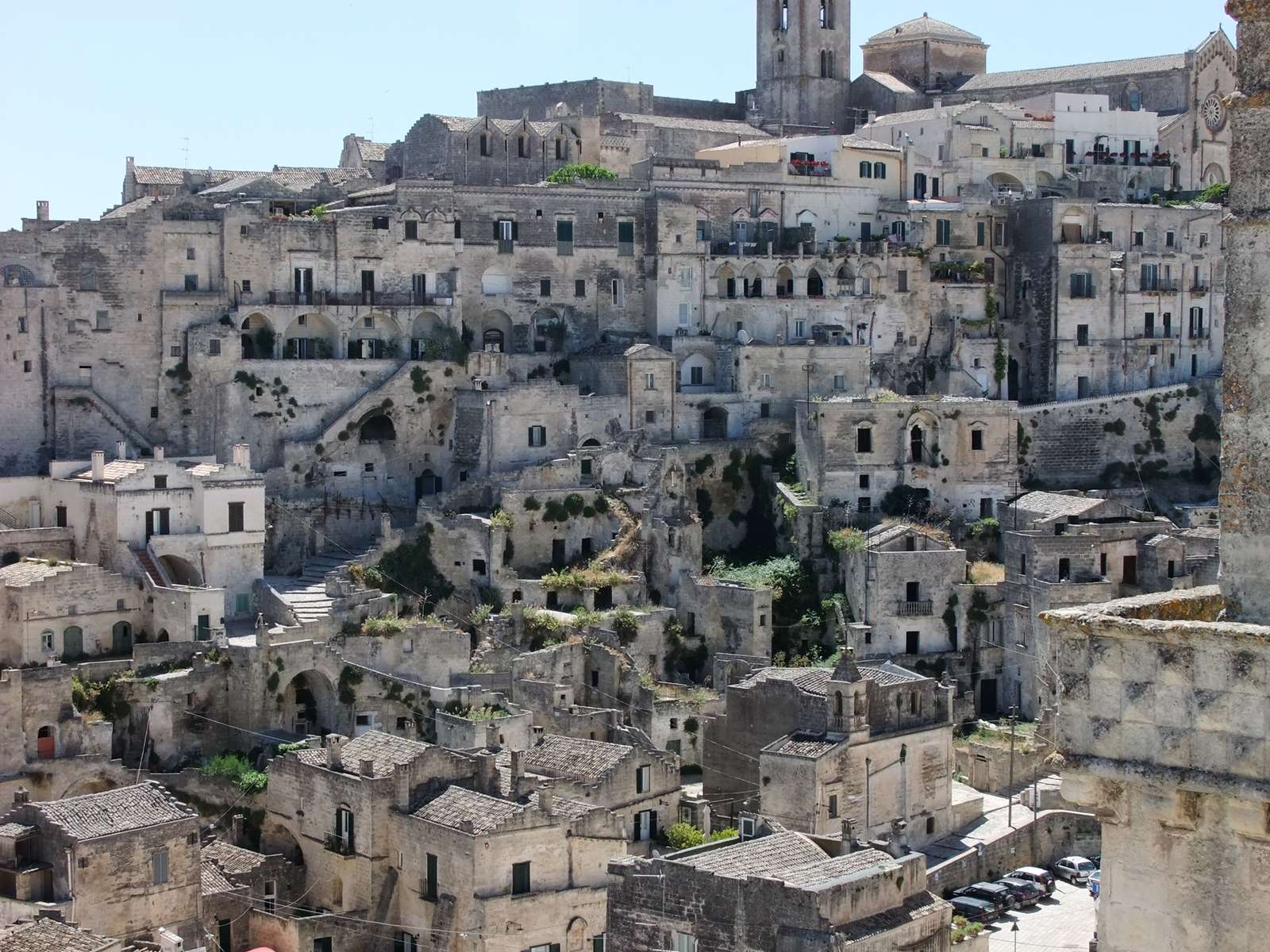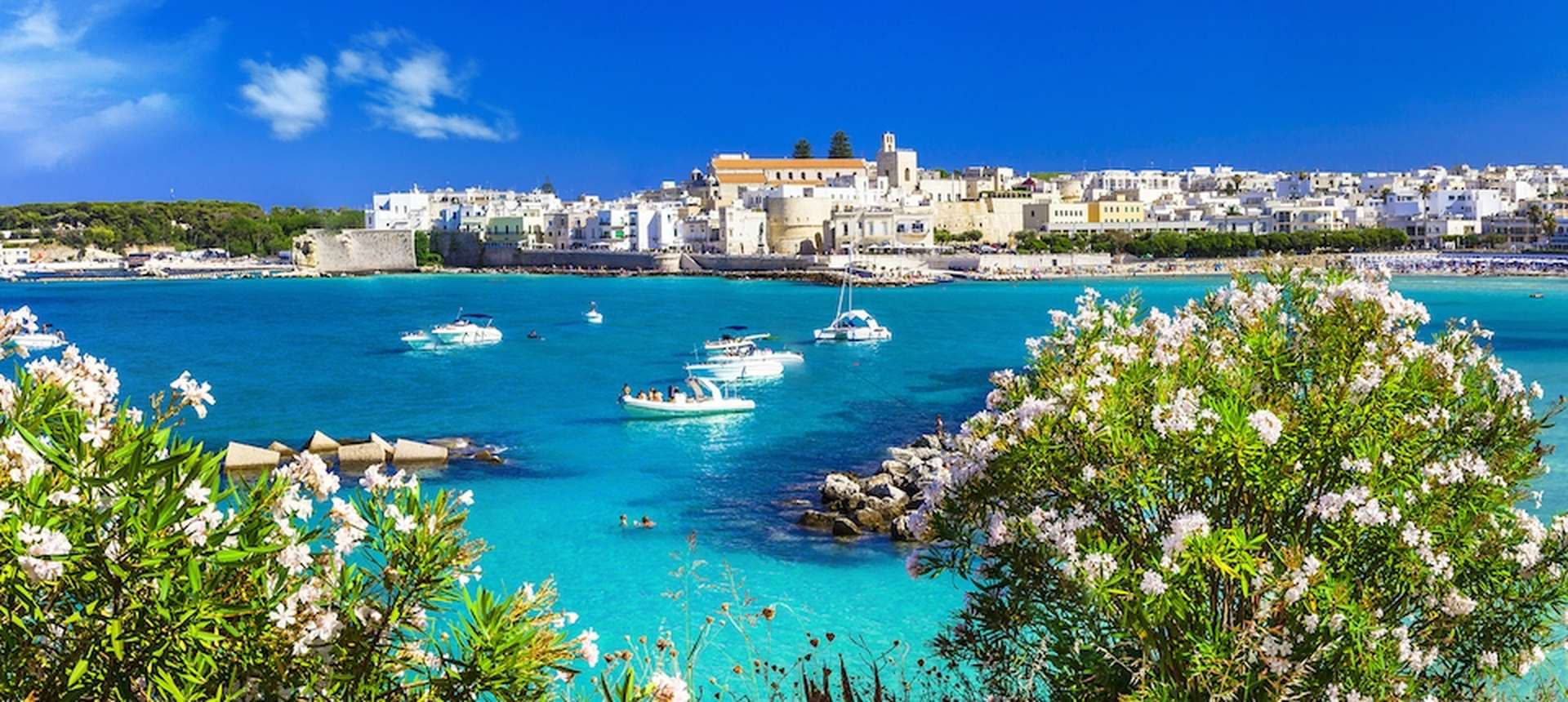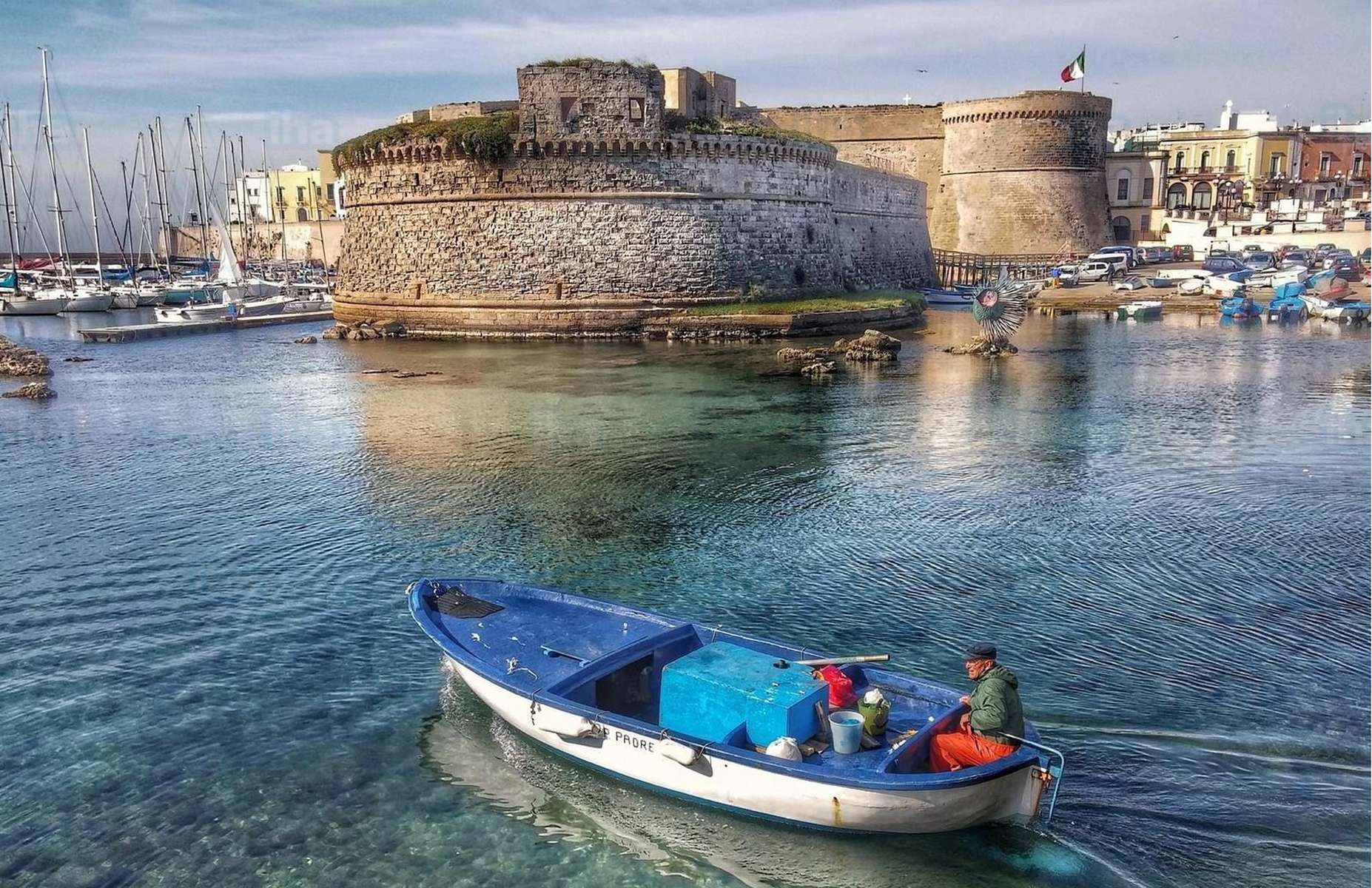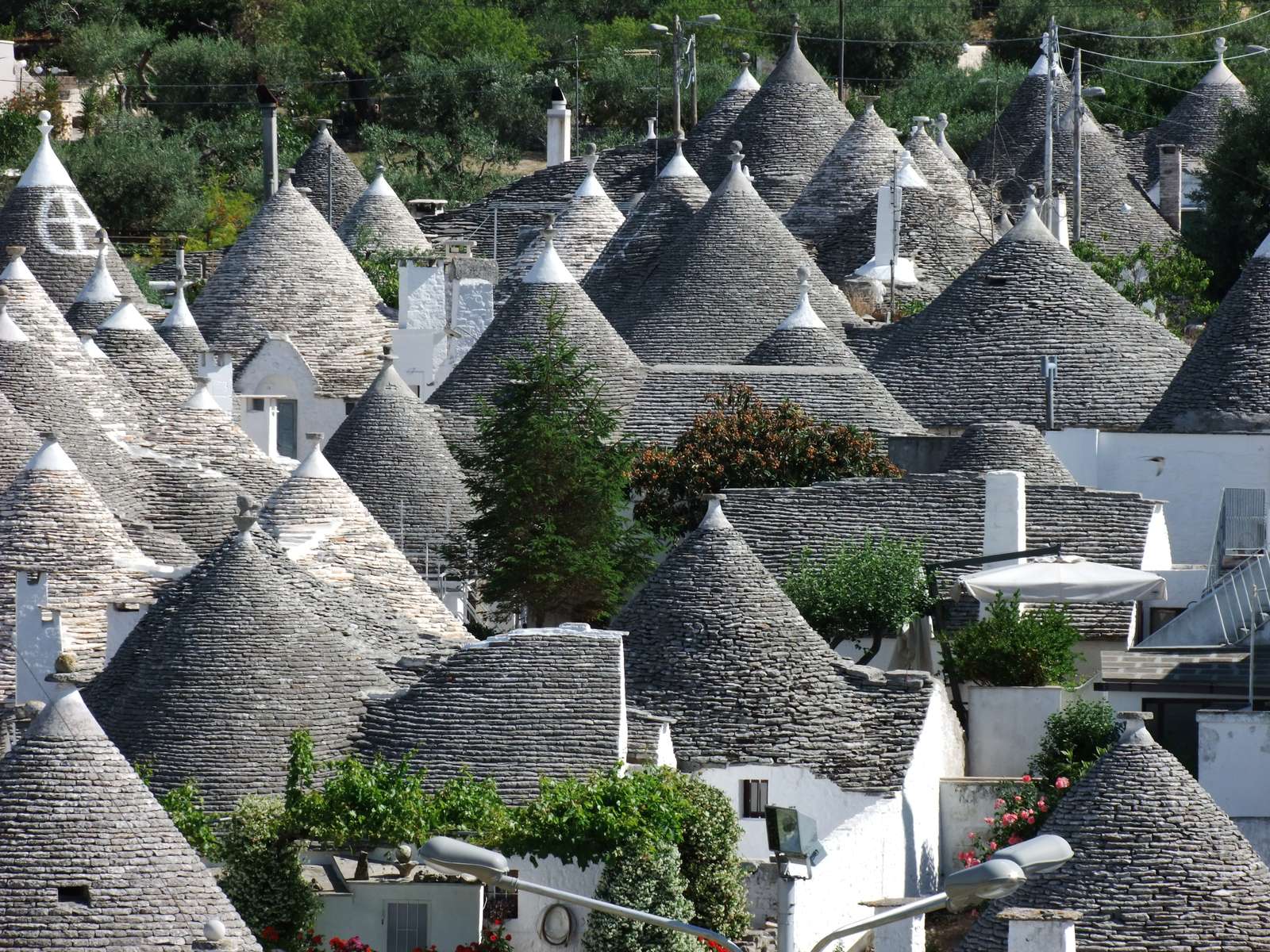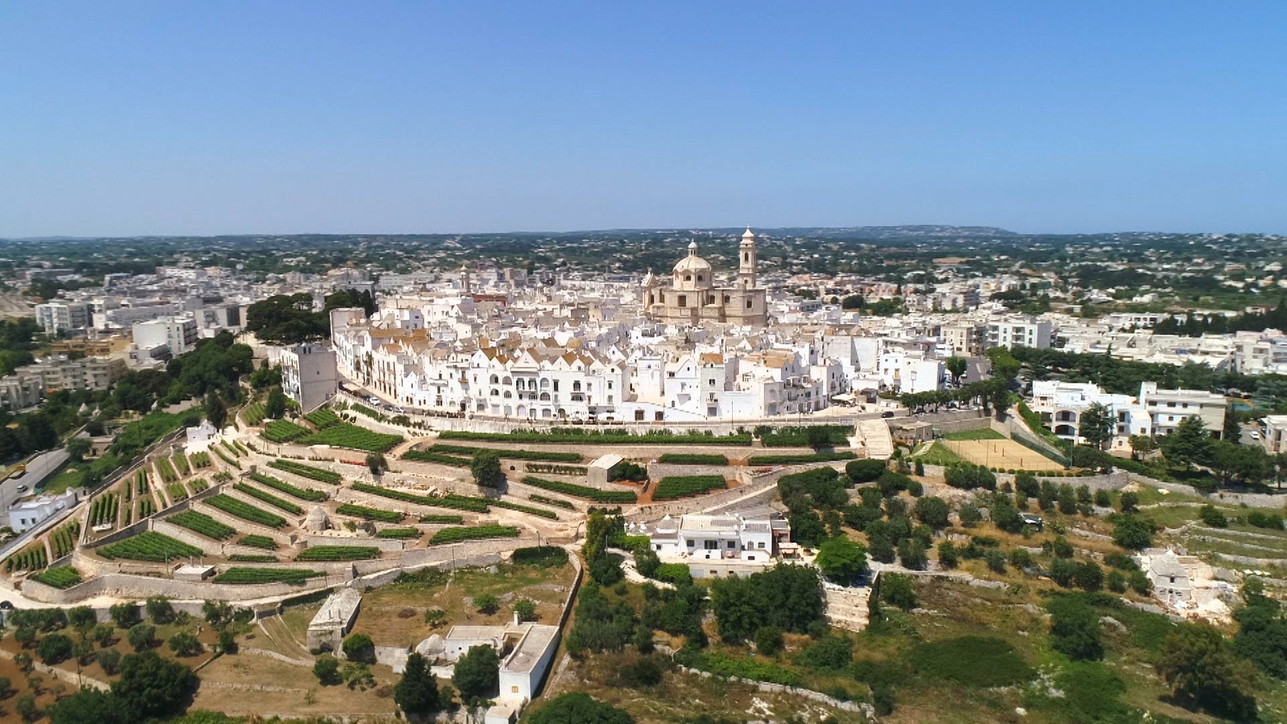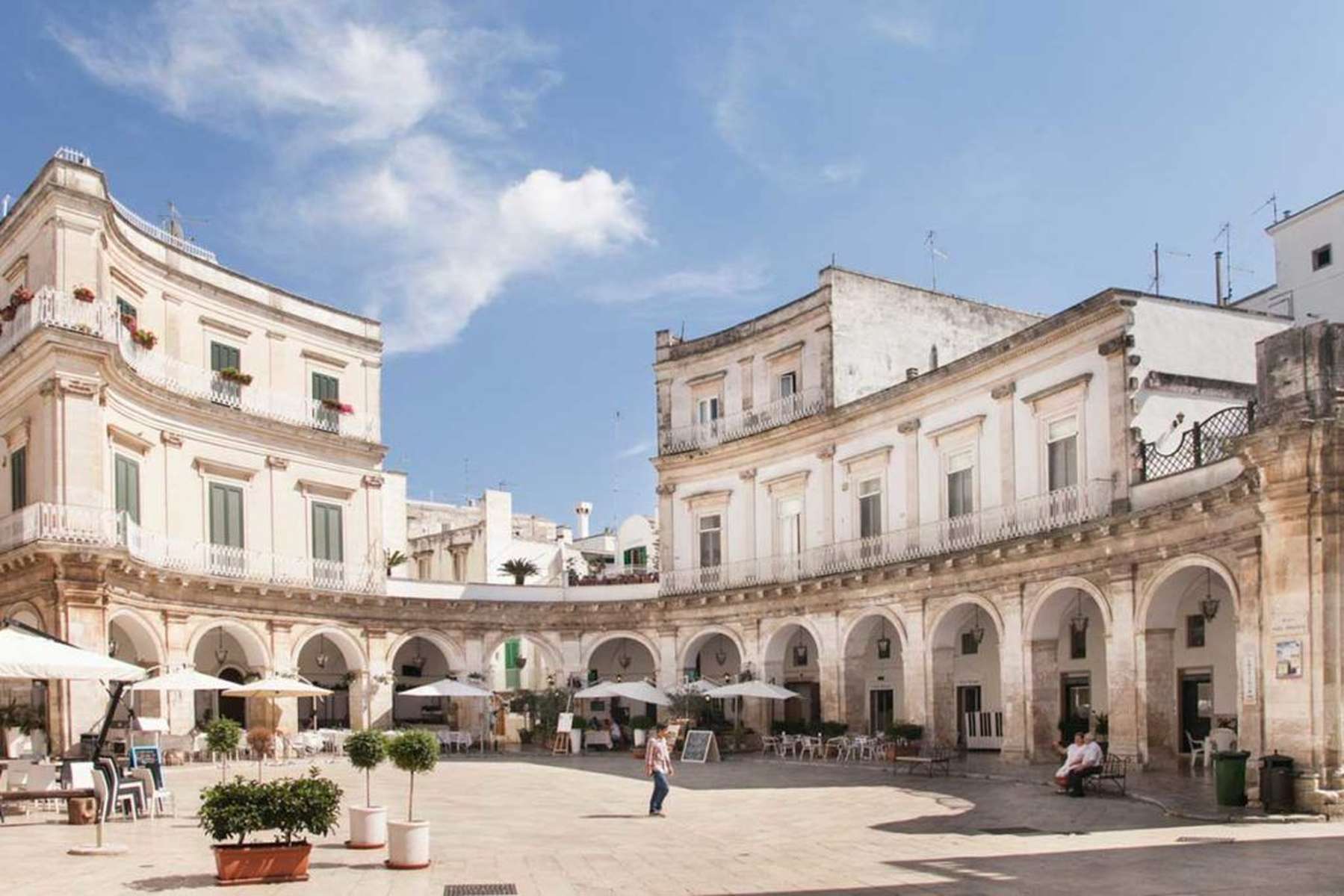50 minutes from Trullo della Pace
Rich in history and architectural and artistic testimonies, especially linked to the Baroque period, is enclosed by walls still visible in many places.
Of the ancient gates to the city, there are only 3: the Arc of Triumph (better known as Porta Napoli), Porta Rudiae and Porta San Biagio.
The beauty of its monuments was known as Athens of the Puglia and the Florence of the South, so well understood the Baroque sensibility that transpires from most of the buildings.
These are the numerous churches that, with their façades worked in Lecce stone, with their decorations, with the wonderful altars that are the mirror of an era lived for art.
The “Pietra Leccese” (Leccese stone) is the building material used for all the monuments of the city, and thanks to its malleability and ease of processing, baroque has developed more here than elsewhere.
To visit:
Piazza Duomo (Duomo square)
Piazza Duomo is one of the rare examples of “closed square”. At one time, in the evenings the doors, of which the impressive hubs are still visible today, were tightened.
Whether it is a clear example of Baroque is also evident from the theoretical solution of the “false facade”.
The visitor entering Piazza Duomo is faced with a church facade, which only “accurate” is observed in a careful view.
You just have to cross the threshold of the portal to find yourself in the side nave of the Church.
The cathedral does not welcome the visitor in front, but is located in parallel with the entrance to the square.
The scenic solution was adopted to prevent the visitor from facing a flat and uncluttered wall.
Duomo – Cattedrale di Santa Maria Assunta
The Cathedral of Santa Maria Assunta is the main place of Catholic worship in Lecce, the parent church of the same metropolitan archdiocese.
It is located in Piazza del Duomo, in the historic center of the city.
A first cathedral of the diocese of Lecce was built in 1144 by bishop Formoso; in 1230, at the wish of bishop Roberto Voltorico, the cathedral was renovated and rebuilt in Romanesque style.
In 1659, Bishop of Lecce Luigi Pappacoda gave to the architect Lecce Giuseppe Zimbalo, called Zingarello, the task of reconstructing the cathedral church in Lecce baroque style.
The architect chose not to alter the plan of the Romanesque cathedral and the first stone was laid on January 1 of the same year.
The construction was carried on from 1659 until 1670, when the new cathedral was solemnly consecrated by Bishop Pappacoda.
Address: Piazza Duomo, 5, Lecce
Opening Time: Morning from 7.00 to 12.00 and afternoon from 16.00 to 18.30.
Price: 1 euro. The entrance to the crypt costs 1,00 €
Web: http://www.cattedraledilecce.it/
Anfiteatro Romano
The Roman amphitheater of Lecce is a Romanesque monument located in the central piazza Sant’Oronzo and dates back to the Augustan era.
It is, along with the theater, the most expressive monument of the importance achieved by Lupiae, the Roman anten to Lecce, between the 1st and 2nd century AD.
The monument was discovered during the construction of the Bank of Italy building, carried out in the early 1900s.
Excavations to bring to light the remnants of the amphitheater began almost immediately, thanks to the wishes of the archaeologist Salento Cosimo De Giorgi and lasted until 1940.
At present it is possible to admire only one third of the entire structure, as the rest remains hidden in the underground of Sant’Oronzo square where there are some buildings and the church of Santa Maria della Grazia.
Address: Piazza Sant’Oronzo, Lecce
Opening time:
From April to May + September: from 10.30 to 12.00 and from 17.00 to 19.00; From June to August: 18.00 – 20.00;
there is the possibility to book guided visits during closing hours.
Basilica di Santa Croce
The Basilica of Santa Croce along with the adjacent former Celestine convent is the highest manifestation of the Lecce baroque.
It is also called the Minor Basilica.
In the area of the present basilica, Gualtieri VI of Brienne had already founded a monastery in the 14th century, but it was only after the middle of the sixteenth century that it was decided to transform the area into a monumental area.
In order to find the place, the houses and properties of the Jews were forced out of the city in 1510.
The works for the basilica were extended for two centuries between the sixteenth and seventeenth centuries, and saw the involvement of the most important city architects of the time .
During the first phase of construction, which began in 1549, ended by 1582 and saw the construction of the lower part of the façade, up to the enormous balcony supported by portraits depicting men and animals. The dome was completed in 1590.
A subsequent stage of work, starting from 1606, during which the three decorated portals were added to the façade, is marked by the commitment of Francesco Antonio Zimbalo.
Address: Via Umberto I, 13, Lecce
Opening hours: from 9 to 12 and from 17 to 20.
Palazzo Vescovile – Episcopio
The original building dates back to the 15th century, at the time of the Bishop Guidano.
It was rebuilt from the 16th-17th centuries by the will of Bishop Scipione Spina.
In the 18th century it was the subject of some works that embellished the prospectus and magnified the environments.
In 1758 the existing facade was erected by Emanuele Manieri. The Lecce architect eliminated the external staircase, and made the prospect a masterpiece of the baroque.
The prospect of the Episcopal is at right angles and therefore aligns to the right of the Seminary and to the left of the Duomo.
Both nine arcades on the right side and six on the opposite side (3 + 3) are interwoven by Doric columns. Considering the prospect, there is the bishop Sozi Carafa’s coat of arms on the portal, in the second order, three niches in which statues are housed (that of the Virgin in the center), while the pocket contains a 1761 clock made by the Lecce Domenico Panico.
Inside there are the apartments of representation, with a vast gallery, those of the bishop’s residence and offices of the diocesan Curia.
In the gallery you can admire the polygon statue of the Assumption and some paintings, including a Virgin with the Child of Catalan, the Crucifixion of St. Peter of Luca Giordano, a Venetian table of the Virgin with the Child and a Holy Family, both coming from the Church of Carmine.
Address: Piazza Duomo, 5, Lecce
Museo della Cartapesta (Papier-machè museum)
Video, images, reconstructions of “shop” make the tour a means of “traveling” in the world of Papier-machè and its symbol city: Lecce.
An indissoluble bond between the city and the art of Papier-machè, renewed by the tradition kept alive by the paperwork shops that fascinate those who roam the scenic scenes of the streets of the Baroque city.
The collection consists of about 80 works of the greatest Lecce paper artists, including Caretta, Capoccia, Guacci, Errico, Pantaleo, Mazzeo, Indigo, Malecore, Gallucci, and covers a time span that from the 18C. comes to our day with the works of international artists such as Emilio Farina and Brazilian Lucia Barata.
The museum is set up in the ground floor rooms of the Carlo V Castle.
Opening hours: From Monday to Friday from 9.00 to 13.00 and from 16.00 to 20.00;
Saturday and Monday from 9.30 to 13.00 and from 16.00 to 20.00.
Museo Archeologico Sigismondo Castromediano
preserves numerous testimonies of Messapian civilization and Roman settlements.
In the prehistoric section, the Porto Badisco Deer Grotto has been rebuilt with interesting rock paintings.
In the Pinacoteca, located on the upper floor of the palace, there are paintings depicting Byzantine and Venetian influences on the work of local artists from the Middle Ages to the Eighteenth Century (works by Bartolomeo Vivarini, Paolo Finoglio, Pacecco De Rosa, Agostino Beltrano, Antonio Verrio and Oronzo Tiso). A section is dedicated to so-called minor arts: pottery, ivory, bronze and baroque silver.
Opening hours: all days excluding Sunday afternoon from 09.00 to 13.30 and from 14.30 to 19.30.
WEB: http://www.comune.lecce.it/vivicitta/museigallerie/sigismondocastromediano
Museo Faggiano
The historic building belonging to the Faggiano family, which serves as a museum, offers interesting historical and archaeological evidence (tombs, cisterns, barns, walkways, etc.), re-emerging during restoration work, referring to different historical periods from Messapians.
L’edificio storico di proprietà della famiglia Faggiano, adibito a museo offre l’opportunità di visitare interessanti testimonianze storiche-archeologiche (tombe, cisterne, granai, camminamenti ecc), riaffiorate durante i lavori di restauro, riferite ad epoche storiche diverse a partire dai Messapi.
Openign hours: from 9.30 to 13.00 and from 16.00 to 20.00.
WEB: http://www.museofaggiano.it/
Museo Diocesano d’arte sacra
There are paintings, sculptures, silverware, and liturgical collections that not only document a path of the diocese’s artistic history, with particular reference to the city, but also testify to the role played by the Church in the life of the believing community.
The paintings span a period of time ranging from the end of the ‘400 to the late’ 700.
From the Venetian table with the Madonna del Carmine to the Madonna del Rosario of the painter Lecce Oronzo Tiso. So it is possible to meet the truth of the testimony of S. Orsola’s faith in the great piece by Paolo Finoglio or the painting Pasce oves meas probable work by N. Poussin. Exposure is enriched by the presence of sculptures and argents, most of which are the liturgical treasures of the Cathedral of Lecce, especially between the sixteenth and seventeenth centuries. Worthy of note is the extraordinary truncate of the Gaetano Starace hunter, intended to welcome the monstrance in solemn exhibitions.
Address: Piazza Duomo, 5, Lecce
Opening hours:
Visit to Cloister: Winter period: from 09.30 to 12.00; from 16.00 to 19.00; Summer period: from 09.30 to 12.00; from 17.00 to 20.00
Visita to Museum: Winter period: From Tuesday to Saturday from 09.30to 12.30; from 16.00 to 19.00.
On Sunday opened only by reservation;
Summer time: from Tuesday ti Saturday from 09.30 to 12.30; from 17.00 to 20.00.
On Sunday only by reservation.
WEB: http://www.comune.lecce.it/vivicitta/museigallerie/artesacra
Pinacoteca d’Arte Francescana
The paintings belonged to the Franciscan Apulian convents.
On the first floor you can also visit the Permanent Exhibition of Father Raffaello Pantaloni (collection of sketches, drawings, photo notes, etc.), Franciscan Father invited to Lecce in the 1930s to realize the frescoes of the parish of S. Antonio in Fulgenzio.
Always in the same building deserves a visit to the Ninfeo.
Address: Via Imperatore Adriano, 50, Lecce
Opening time: From Monday to Friday from 9.00 to 12.00 and from 16.00 to 18.30.
WEB: http://www.pinacotecafrancescanalecce.it/
Lecce: Other to visit
The list of the buildings to be visited in Lecce would occupy an entire website on its own … so I refer you to this beautiful site from which I have taken many of the information here:http://www.zonzofox.com/it/lecce/cosa-vedere/esplora/attrazioni
